Analyzing Inflation's Effects on the Tourism Sector in the UK
VerifiedAdded on 2023/06/05
|8
|1958
|69
Report
AI Summary
This report, a Foundation Year Research Project, investigates the multifaceted impact of inflation on the UK tourism industry. It begins by defining inflation and outlining its causes, supported by statistical data illustrating the rising inflation rates in the UK and its effects on Small and Medium Enterprises (SMEs) within the tourism sector. The report then delves into both the positive and negative consequences of inflation on tourism, offering a balanced perspective. The methodology includes analysis of government and industry reports, as well as qualitative research to understand the viewpoints of various authors. The conclusion proposes strategies the tourism industry can employ to mitigate the negative effects of inflation, such as proactive market trend evaluations, supply chain optimization, cost reduction, and employee engagement to enhance productivity and profitability, providing recommendations for sustainable business practices within the tourism sector during inflationary periods.
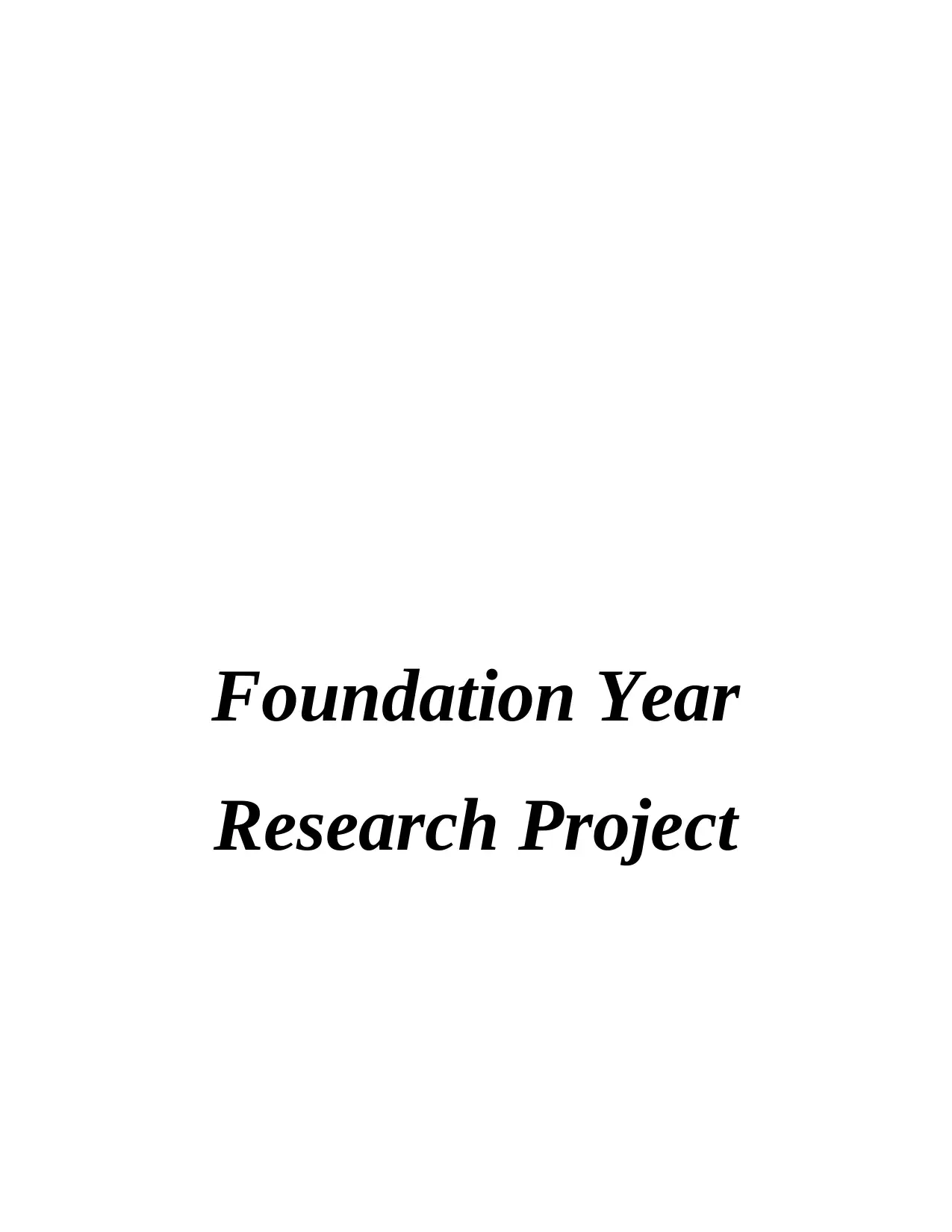
Foundation Year
Research Project
Research Project
Paraphrase This Document
Need a fresh take? Get an instant paraphrase of this document with our AI Paraphraser
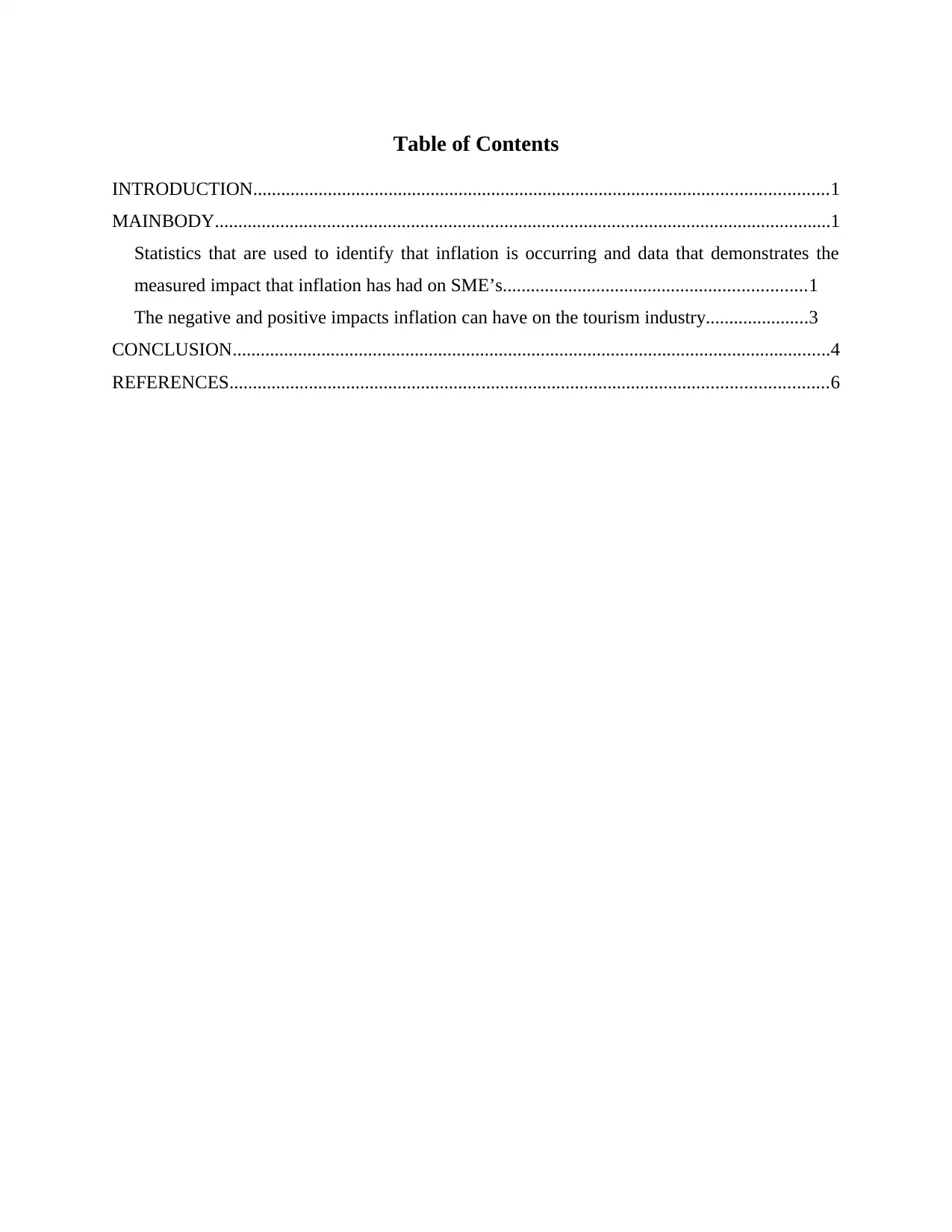
Table of Contents
INTRODUCTION...........................................................................................................................1
MAINBODY....................................................................................................................................1
Statistics that are used to identify that inflation is occurring and data that demonstrates the
measured impact that inflation has had on SME’s.................................................................1
The negative and positive impacts inflation can have on the tourism industry......................3
CONCLUSION................................................................................................................................4
REFERENCES................................................................................................................................6
INTRODUCTION...........................................................................................................................1
MAINBODY....................................................................................................................................1
Statistics that are used to identify that inflation is occurring and data that demonstrates the
measured impact that inflation has had on SME’s.................................................................1
The negative and positive impacts inflation can have on the tourism industry......................3
CONCLUSION................................................................................................................................4
REFERENCES................................................................................................................................6
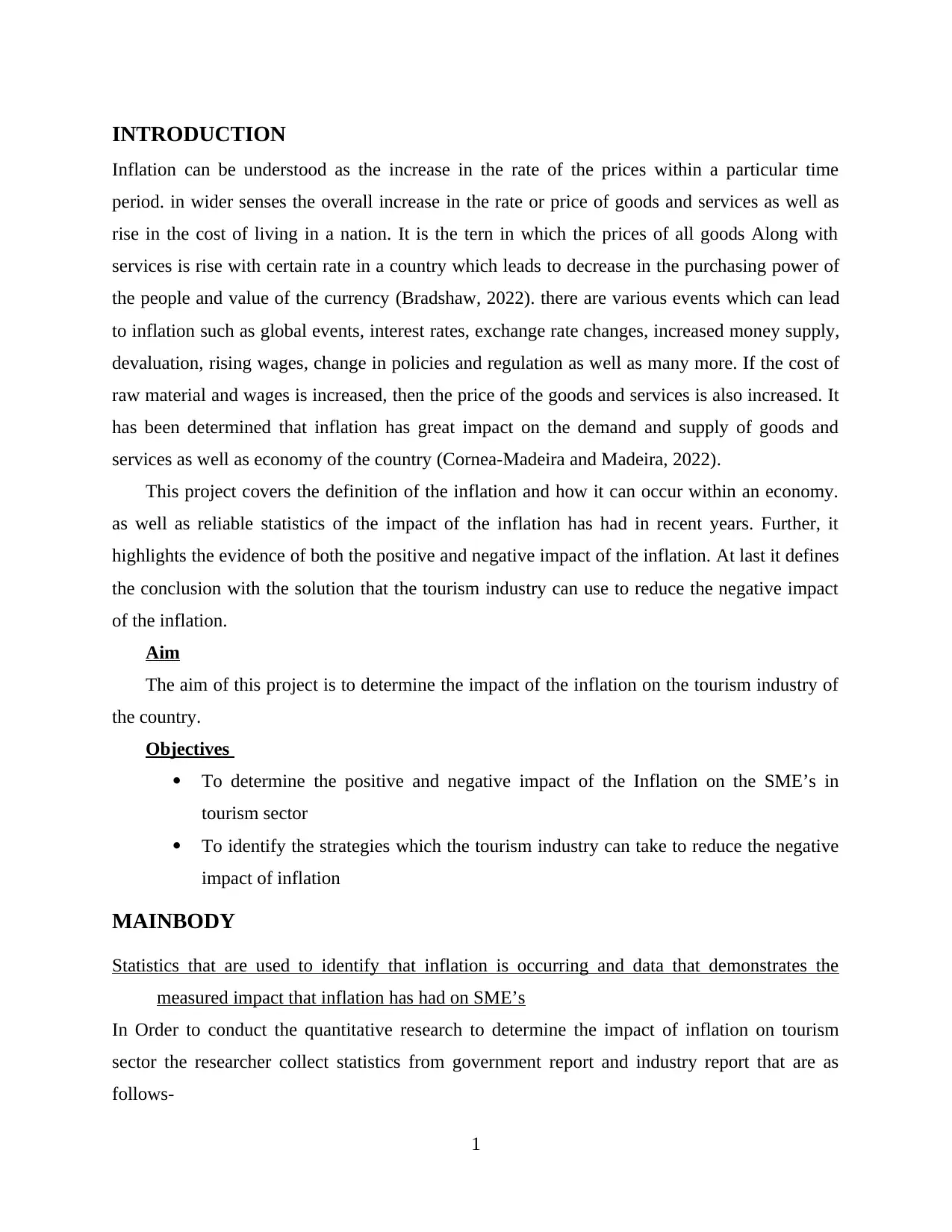
INTRODUCTION
Inflation can be understood as the increase in the rate of the prices within a particular time
period. in wider senses the overall increase in the rate or price of goods and services as well as
rise in the cost of living in a nation. It is the tern in which the prices of all goods Along with
services is rise with certain rate in a country which leads to decrease in the purchasing power of
the people and value of the currency (Bradshaw, 2022). there are various events which can lead
to inflation such as global events, interest rates, exchange rate changes, increased money supply,
devaluation, rising wages, change in policies and regulation as well as many more. If the cost of
raw material and wages is increased, then the price of the goods and services is also increased. It
has been determined that inflation has great impact on the demand and supply of goods and
services as well as economy of the country (Cornea‐Madeira and Madeira, 2022).
This project covers the definition of the inflation and how it can occur within an economy.
as well as reliable statistics of the impact of the inflation has had in recent years. Further, it
highlights the evidence of both the positive and negative impact of the inflation. At last it defines
the conclusion with the solution that the tourism industry can use to reduce the negative impact
of the inflation.
Aim
The aim of this project is to determine the impact of the inflation on the tourism industry of
the country.
Objectives
To determine the positive and negative impact of the Inflation on the SME’s in
tourism sector
To identify the strategies which the tourism industry can take to reduce the negative
impact of inflation
MAINBODY
Statistics that are used to identify that inflation is occurring and data that demonstrates the
measured impact that inflation has had on SME’s
In Order to conduct the quantitative research to determine the impact of inflation on tourism
sector the researcher collect statistics from government report and industry report that are as
follows-
1
Inflation can be understood as the increase in the rate of the prices within a particular time
period. in wider senses the overall increase in the rate or price of goods and services as well as
rise in the cost of living in a nation. It is the tern in which the prices of all goods Along with
services is rise with certain rate in a country which leads to decrease in the purchasing power of
the people and value of the currency (Bradshaw, 2022). there are various events which can lead
to inflation such as global events, interest rates, exchange rate changes, increased money supply,
devaluation, rising wages, change in policies and regulation as well as many more. If the cost of
raw material and wages is increased, then the price of the goods and services is also increased. It
has been determined that inflation has great impact on the demand and supply of goods and
services as well as economy of the country (Cornea‐Madeira and Madeira, 2022).
This project covers the definition of the inflation and how it can occur within an economy.
as well as reliable statistics of the impact of the inflation has had in recent years. Further, it
highlights the evidence of both the positive and negative impact of the inflation. At last it defines
the conclusion with the solution that the tourism industry can use to reduce the negative impact
of the inflation.
Aim
The aim of this project is to determine the impact of the inflation on the tourism industry of
the country.
Objectives
To determine the positive and negative impact of the Inflation on the SME’s in
tourism sector
To identify the strategies which the tourism industry can take to reduce the negative
impact of inflation
MAINBODY
Statistics that are used to identify that inflation is occurring and data that demonstrates the
measured impact that inflation has had on SME’s
In Order to conduct the quantitative research to determine the impact of inflation on tourism
sector the researcher collect statistics from government report and industry report that are as
follows-
1
⊘ This is a preview!⊘
Do you want full access?
Subscribe today to unlock all pages.

Trusted by 1+ million students worldwide
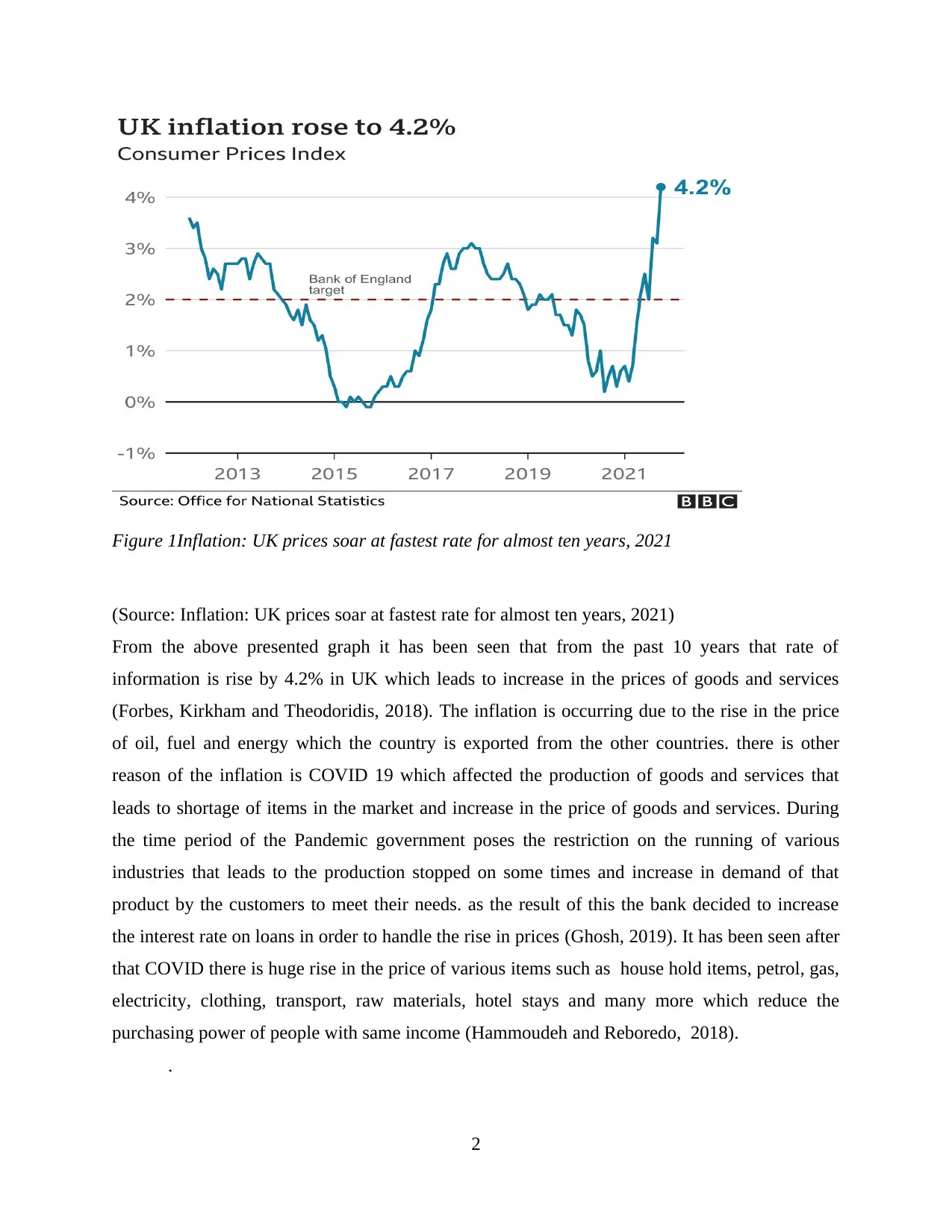
Figure 1Inflation: UK prices soar at fastest rate for almost ten years, 2021
(Source: Inflation: UK prices soar at fastest rate for almost ten years, 2021)
From the above presented graph it has been seen that from the past 10 years that rate of
information is rise by 4.2% in UK which leads to increase in the prices of goods and services
(Forbes, Kirkham and Theodoridis, 2018). The inflation is occurring due to the rise in the price
of oil, fuel and energy which the country is exported from the other countries. there is other
reason of the inflation is COVID 19 which affected the production of goods and services that
leads to shortage of items in the market and increase in the price of goods and services. During
the time period of the Pandemic government poses the restriction on the running of various
industries that leads to the production stopped on some times and increase in demand of that
product by the customers to meet their needs. as the result of this the bank decided to increase
the interest rate on loans in order to handle the rise in prices (Ghosh, 2019). It has been seen after
that COVID there is huge rise in the price of various items such as house hold items, petrol, gas,
electricity, clothing, transport, raw materials, hotel stays and many more which reduce the
purchasing power of people with same income (Hammoudeh and Reboredo, 2018).
.
2
(Source: Inflation: UK prices soar at fastest rate for almost ten years, 2021)
From the above presented graph it has been seen that from the past 10 years that rate of
information is rise by 4.2% in UK which leads to increase in the prices of goods and services
(Forbes, Kirkham and Theodoridis, 2018). The inflation is occurring due to the rise in the price
of oil, fuel and energy which the country is exported from the other countries. there is other
reason of the inflation is COVID 19 which affected the production of goods and services that
leads to shortage of items in the market and increase in the price of goods and services. During
the time period of the Pandemic government poses the restriction on the running of various
industries that leads to the production stopped on some times and increase in demand of that
product by the customers to meet their needs. as the result of this the bank decided to increase
the interest rate on loans in order to handle the rise in prices (Ghosh, 2019). It has been seen after
that COVID there is huge rise in the price of various items such as house hold items, petrol, gas,
electricity, clothing, transport, raw materials, hotel stays and many more which reduce the
purchasing power of people with same income (Hammoudeh and Reboredo, 2018).
.
2
Paraphrase This Document
Need a fresh take? Get an instant paraphrase of this document with our AI Paraphraser
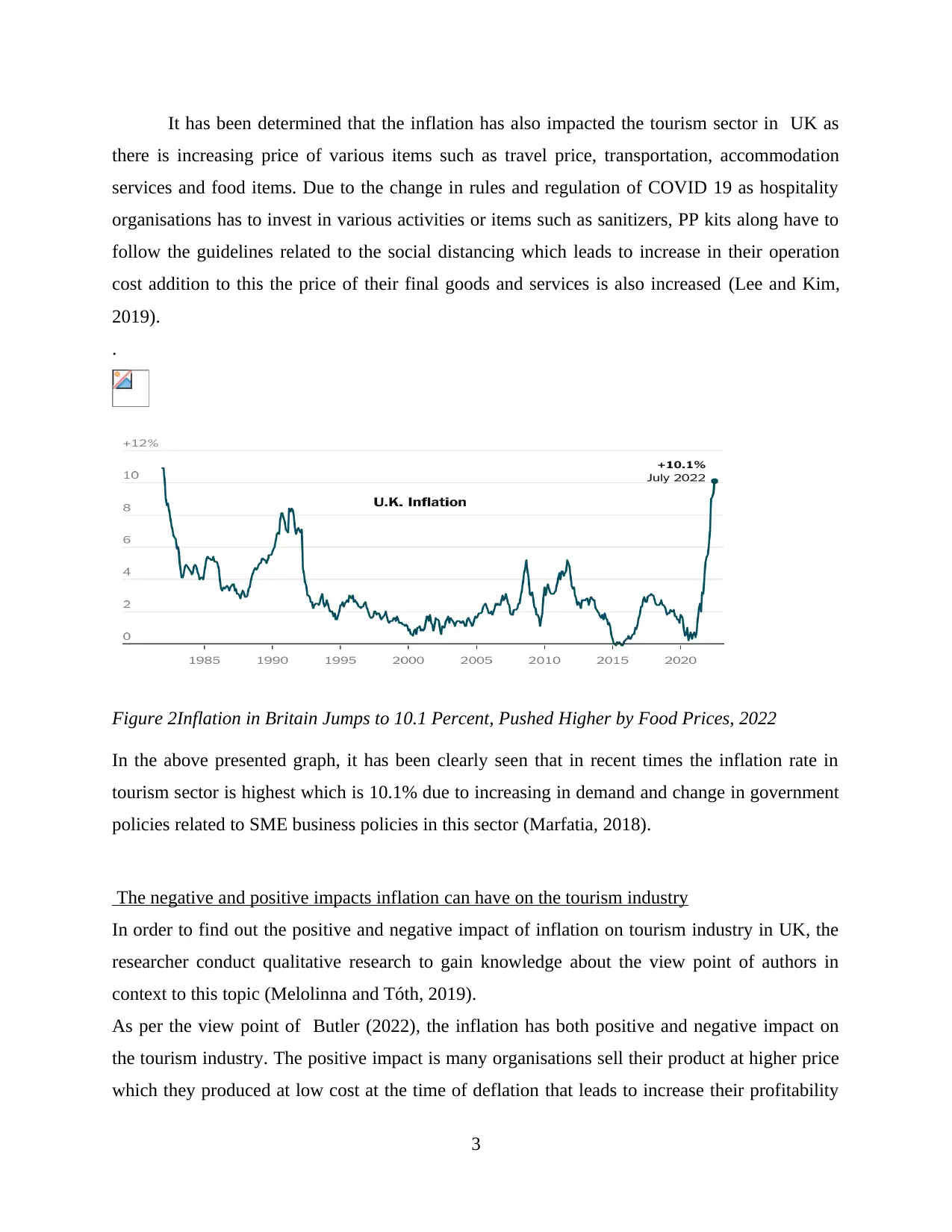
It has been determined that the inflation has also impacted the tourism sector in UK as
there is increasing price of various items such as travel price, transportation, accommodation
services and food items. Due to the change in rules and regulation of COVID 19 as hospitality
organisations has to invest in various activities or items such as sanitizers, PP kits along have to
follow the guidelines related to the social distancing which leads to increase in their operation
cost addition to this the price of their final goods and services is also increased (Lee and Kim,
2019).
.
Figure 2Inflation in Britain Jumps to 10.1 Percent, Pushed Higher by Food Prices, 2022
In the above presented graph, it has been clearly seen that in recent times the inflation rate in
tourism sector is highest which is 10.1% due to increasing in demand and change in government
policies related to SME business policies in this sector (Marfatia, 2018).
The negative and positive impacts inflation can have on the tourism industry
In order to find out the positive and negative impact of inflation on tourism industry in UK, the
researcher conduct qualitative research to gain knowledge about the view point of authors in
context to this topic (Melolinna and Tóth, 2019).
As per the view point of Butler (2022), the inflation has both positive and negative impact on
the tourism industry. The positive impact is many organisations sell their product at higher price
which they produced at low cost at the time of deflation that leads to increase their profitability
3
there is increasing price of various items such as travel price, transportation, accommodation
services and food items. Due to the change in rules and regulation of COVID 19 as hospitality
organisations has to invest in various activities or items such as sanitizers, PP kits along have to
follow the guidelines related to the social distancing which leads to increase in their operation
cost addition to this the price of their final goods and services is also increased (Lee and Kim,
2019).
.
Figure 2Inflation in Britain Jumps to 10.1 Percent, Pushed Higher by Food Prices, 2022
In the above presented graph, it has been clearly seen that in recent times the inflation rate in
tourism sector is highest which is 10.1% due to increasing in demand and change in government
policies related to SME business policies in this sector (Marfatia, 2018).
The negative and positive impacts inflation can have on the tourism industry
In order to find out the positive and negative impact of inflation on tourism industry in UK, the
researcher conduct qualitative research to gain knowledge about the view point of authors in
context to this topic (Melolinna and Tóth, 2019).
As per the view point of Butler (2022), the inflation has both positive and negative impact on
the tourism industry. The positive impact is many organisations sell their product at higher price
which they produced at low cost at the time of deflation that leads to increase their profitability
3
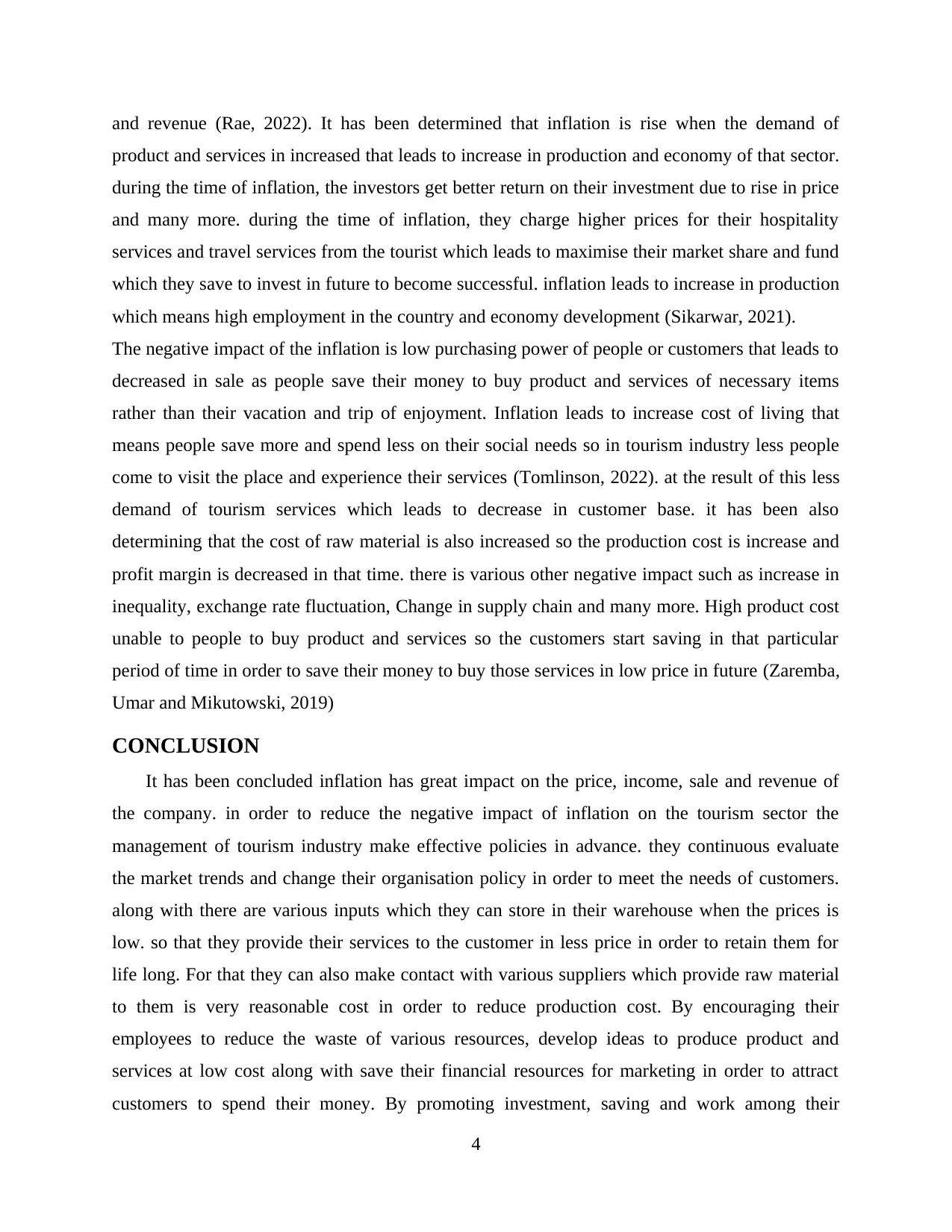
and revenue (Rae, 2022). It has been determined that inflation is rise when the demand of
product and services in increased that leads to increase in production and economy of that sector.
during the time of inflation, the investors get better return on their investment due to rise in price
and many more. during the time of inflation, they charge higher prices for their hospitality
services and travel services from the tourist which leads to maximise their market share and fund
which they save to invest in future to become successful. inflation leads to increase in production
which means high employment in the country and economy development (Sikarwar, 2021).
The negative impact of the inflation is low purchasing power of people or customers that leads to
decreased in sale as people save their money to buy product and services of necessary items
rather than their vacation and trip of enjoyment. Inflation leads to increase cost of living that
means people save more and spend less on their social needs so in tourism industry less people
come to visit the place and experience their services (Tomlinson, 2022). at the result of this less
demand of tourism services which leads to decrease in customer base. it has been also
determining that the cost of raw material is also increased so the production cost is increase and
profit margin is decreased in that time. there is various other negative impact such as increase in
inequality, exchange rate fluctuation, Change in supply chain and many more. High product cost
unable to people to buy product and services so the customers start saving in that particular
period of time in order to save their money to buy those services in low price in future (Zaremba,
Umar and Mikutowski, 2019)
CONCLUSION
It has been concluded inflation has great impact on the price, income, sale and revenue of
the company. in order to reduce the negative impact of inflation on the tourism sector the
management of tourism industry make effective policies in advance. they continuous evaluate
the market trends and change their organisation policy in order to meet the needs of customers.
along with there are various inputs which they can store in their warehouse when the prices is
low. so that they provide their services to the customer in less price in order to retain them for
life long. For that they can also make contact with various suppliers which provide raw material
to them is very reasonable cost in order to reduce production cost. By encouraging their
employees to reduce the waste of various resources, develop ideas to produce product and
services at low cost along with save their financial resources for marketing in order to attract
customers to spend their money. By promoting investment, saving and work among their
4
product and services in increased that leads to increase in production and economy of that sector.
during the time of inflation, the investors get better return on their investment due to rise in price
and many more. during the time of inflation, they charge higher prices for their hospitality
services and travel services from the tourist which leads to maximise their market share and fund
which they save to invest in future to become successful. inflation leads to increase in production
which means high employment in the country and economy development (Sikarwar, 2021).
The negative impact of the inflation is low purchasing power of people or customers that leads to
decreased in sale as people save their money to buy product and services of necessary items
rather than their vacation and trip of enjoyment. Inflation leads to increase cost of living that
means people save more and spend less on their social needs so in tourism industry less people
come to visit the place and experience their services (Tomlinson, 2022). at the result of this less
demand of tourism services which leads to decrease in customer base. it has been also
determining that the cost of raw material is also increased so the production cost is increase and
profit margin is decreased in that time. there is various other negative impact such as increase in
inequality, exchange rate fluctuation, Change in supply chain and many more. High product cost
unable to people to buy product and services so the customers start saving in that particular
period of time in order to save their money to buy those services in low price in future (Zaremba,
Umar and Mikutowski, 2019)
CONCLUSION
It has been concluded inflation has great impact on the price, income, sale and revenue of
the company. in order to reduce the negative impact of inflation on the tourism sector the
management of tourism industry make effective policies in advance. they continuous evaluate
the market trends and change their organisation policy in order to meet the needs of customers.
along with there are various inputs which they can store in their warehouse when the prices is
low. so that they provide their services to the customer in less price in order to retain them for
life long. For that they can also make contact with various suppliers which provide raw material
to them is very reasonable cost in order to reduce production cost. By encouraging their
employees to reduce the waste of various resources, develop ideas to produce product and
services at low cost along with save their financial resources for marketing in order to attract
customers to spend their money. By promoting investment, saving and work among their
4
⊘ This is a preview!⊘
Do you want full access?
Subscribe today to unlock all pages.

Trusted by 1+ million students worldwide
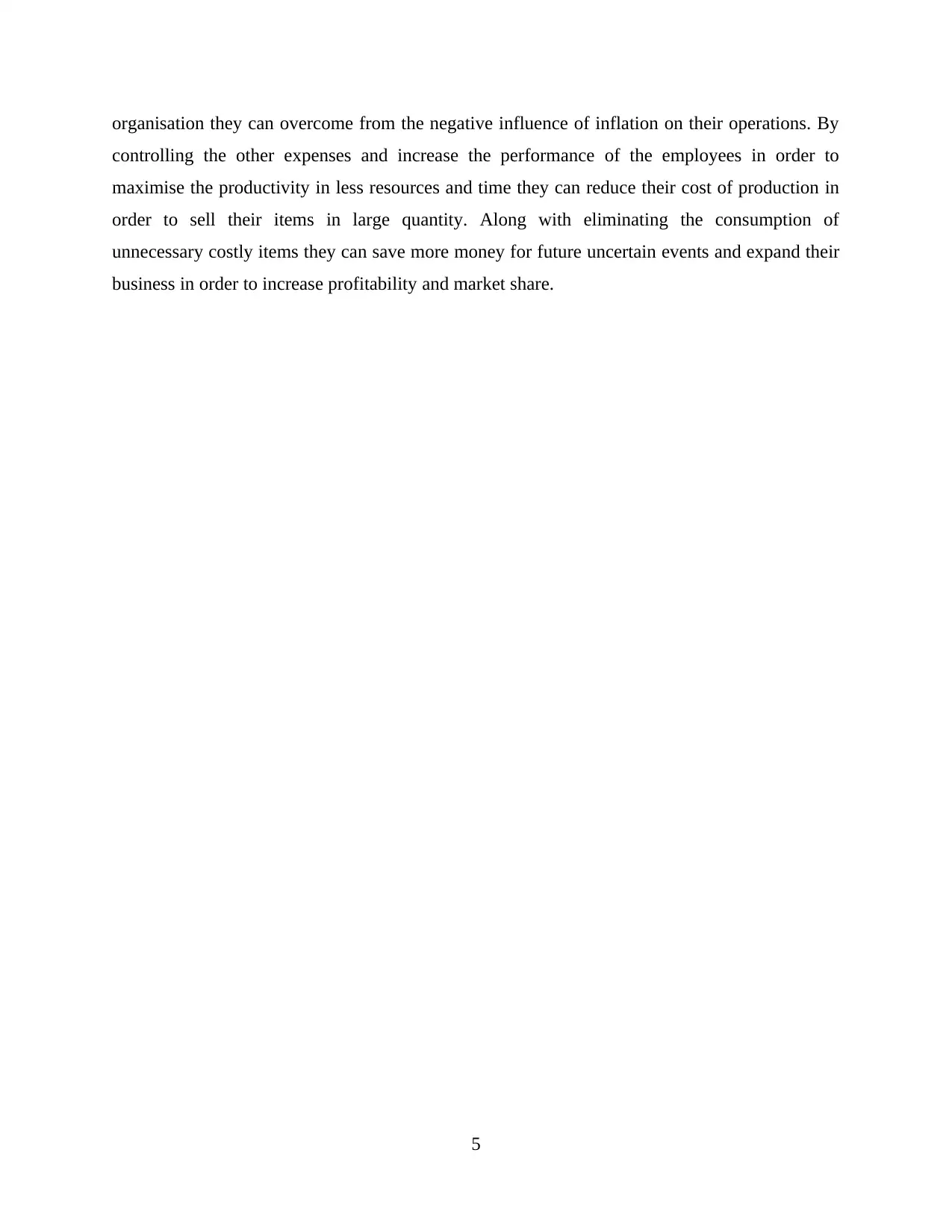
organisation they can overcome from the negative influence of inflation on their operations. By
controlling the other expenses and increase the performance of the employees in order to
maximise the productivity in less resources and time they can reduce their cost of production in
order to sell their items in large quantity. Along with eliminating the consumption of
unnecessary costly items they can save more money for future uncertain events and expand their
business in order to increase profitability and market share.
5
controlling the other expenses and increase the performance of the employees in order to
maximise the productivity in less resources and time they can reduce their cost of production in
order to sell their items in large quantity. Along with eliminating the consumption of
unnecessary costly items they can save more money for future uncertain events and expand their
business in order to increase profitability and market share.
5
Paraphrase This Document
Need a fresh take? Get an instant paraphrase of this document with our AI Paraphraser
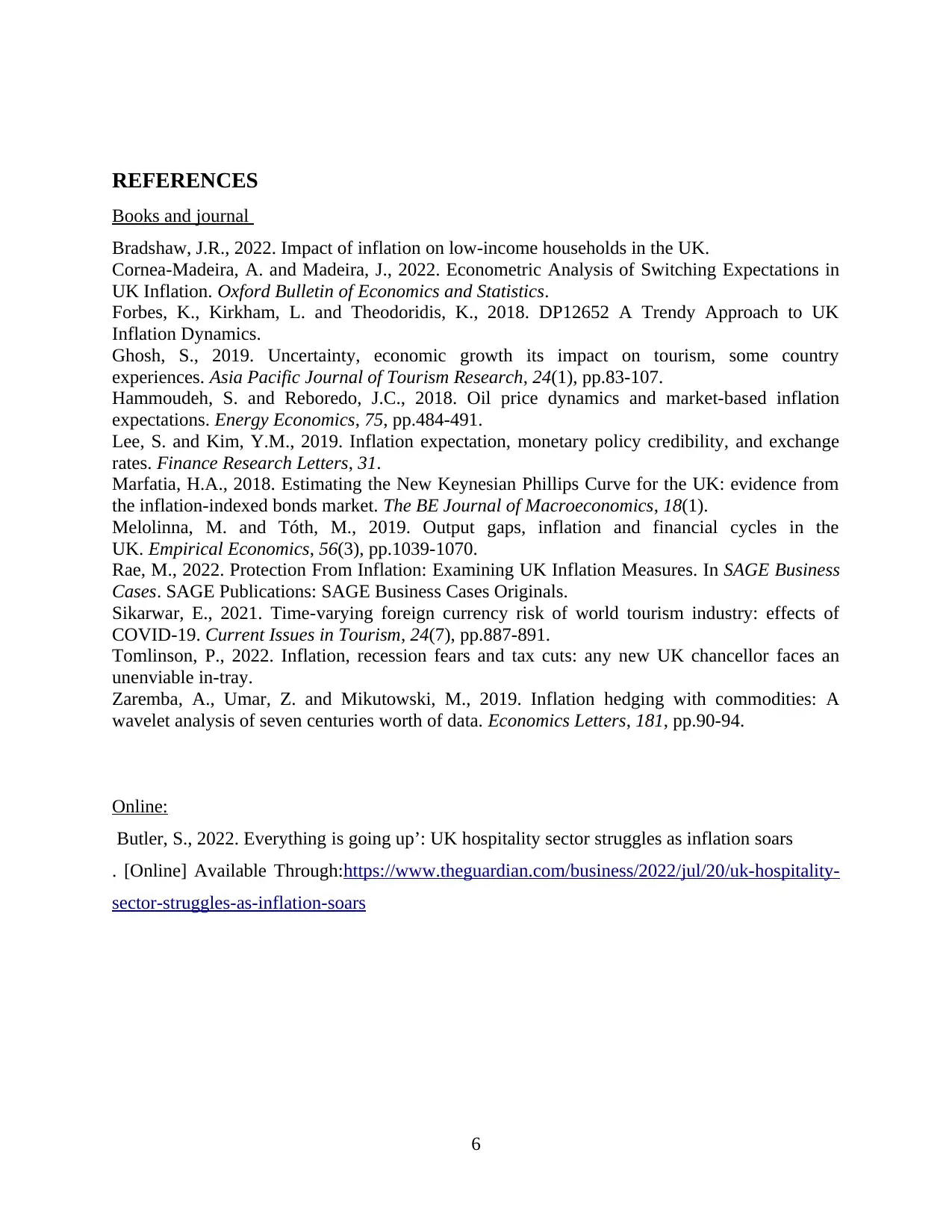
REFERENCES
Books and journal
Bradshaw, J.R., 2022. Impact of inflation on low-income households in the UK.
Cornea‐Madeira, A. and Madeira, J., 2022. Econometric Analysis of Switching Expectations in
UK Inflation. Oxford Bulletin of Economics and Statistics.
Forbes, K., Kirkham, L. and Theodoridis, K., 2018. DP12652 A Trendy Approach to UK
Inflation Dynamics.
Ghosh, S., 2019. Uncertainty, economic growth its impact on tourism, some country
experiences. Asia Pacific Journal of Tourism Research, 24(1), pp.83-107.
Hammoudeh, S. and Reboredo, J.C., 2018. Oil price dynamics and market-based inflation
expectations. Energy Economics, 75, pp.484-491.
Lee, S. and Kim, Y.M., 2019. Inflation expectation, monetary policy credibility, and exchange
rates. Finance Research Letters, 31.
Marfatia, H.A., 2018. Estimating the New Keynesian Phillips Curve for the UK: evidence from
the inflation-indexed bonds market. The BE Journal of Macroeconomics, 18(1).
Melolinna, M. and Tóth, M., 2019. Output gaps, inflation and financial cycles in the
UK. Empirical Economics, 56(3), pp.1039-1070.
Rae, M., 2022. Protection From Inflation: Examining UK Inflation Measures. In SAGE Business
Cases. SAGE Publications: SAGE Business Cases Originals.
Sikarwar, E., 2021. Time-varying foreign currency risk of world tourism industry: effects of
COVID-19. Current Issues in Tourism, 24(7), pp.887-891.
Tomlinson, P., 2022. Inflation, recession fears and tax cuts: any new UK chancellor faces an
unenviable in-tray.
Zaremba, A., Umar, Z. and Mikutowski, M., 2019. Inflation hedging with commodities: A
wavelet analysis of seven centuries worth of data. Economics Letters, 181, pp.90-94.
Online:
Butler, S., 2022. Everything is going up’: UK hospitality sector struggles as inflation soars
. [Online] Available Through:https://www.theguardian.com/business/2022/jul/20/uk-hospitality-
sector-struggles-as-inflation-soars
6
Books and journal
Bradshaw, J.R., 2022. Impact of inflation on low-income households in the UK.
Cornea‐Madeira, A. and Madeira, J., 2022. Econometric Analysis of Switching Expectations in
UK Inflation. Oxford Bulletin of Economics and Statistics.
Forbes, K., Kirkham, L. and Theodoridis, K., 2018. DP12652 A Trendy Approach to UK
Inflation Dynamics.
Ghosh, S., 2019. Uncertainty, economic growth its impact on tourism, some country
experiences. Asia Pacific Journal of Tourism Research, 24(1), pp.83-107.
Hammoudeh, S. and Reboredo, J.C., 2018. Oil price dynamics and market-based inflation
expectations. Energy Economics, 75, pp.484-491.
Lee, S. and Kim, Y.M., 2019. Inflation expectation, monetary policy credibility, and exchange
rates. Finance Research Letters, 31.
Marfatia, H.A., 2018. Estimating the New Keynesian Phillips Curve for the UK: evidence from
the inflation-indexed bonds market. The BE Journal of Macroeconomics, 18(1).
Melolinna, M. and Tóth, M., 2019. Output gaps, inflation and financial cycles in the
UK. Empirical Economics, 56(3), pp.1039-1070.
Rae, M., 2022. Protection From Inflation: Examining UK Inflation Measures. In SAGE Business
Cases. SAGE Publications: SAGE Business Cases Originals.
Sikarwar, E., 2021. Time-varying foreign currency risk of world tourism industry: effects of
COVID-19. Current Issues in Tourism, 24(7), pp.887-891.
Tomlinson, P., 2022. Inflation, recession fears and tax cuts: any new UK chancellor faces an
unenviable in-tray.
Zaremba, A., Umar, Z. and Mikutowski, M., 2019. Inflation hedging with commodities: A
wavelet analysis of seven centuries worth of data. Economics Letters, 181, pp.90-94.
Online:
Butler, S., 2022. Everything is going up’: UK hospitality sector struggles as inflation soars
. [Online] Available Through:https://www.theguardian.com/business/2022/jul/20/uk-hospitality-
sector-struggles-as-inflation-soars
6
1 out of 8
Related Documents
Your All-in-One AI-Powered Toolkit for Academic Success.
+13062052269
info@desklib.com
Available 24*7 on WhatsApp / Email
![[object Object]](/_next/static/media/star-bottom.7253800d.svg)
Unlock your academic potential
Copyright © 2020–2025 A2Z Services. All Rights Reserved. Developed and managed by ZUCOL.



